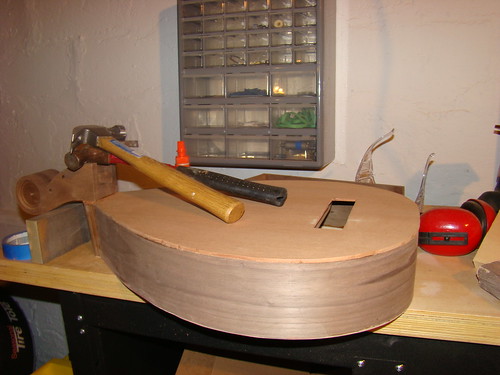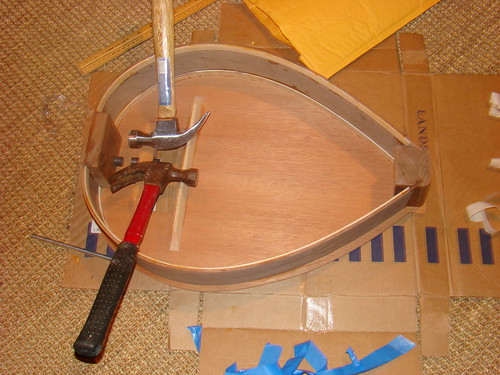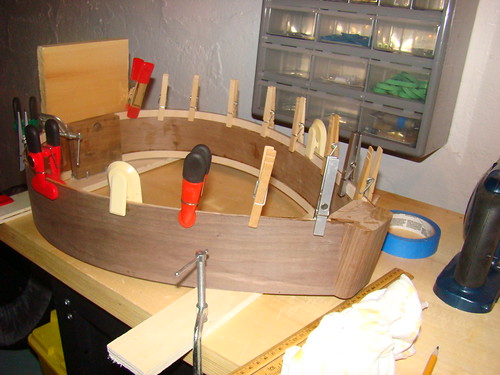Well, kinda. This morning I went down to the Mega-Lo Hardware and got some supplies to carry me through to the end of this project...namely some wood filler, a chisel, some new jigsaw blades (maybe this will cure my fear of the jigsaw), and a few other things that I'll detail below.
This morning I took the pedal steel off of the hurdy gurdy. It looked like this:

Note the overhang -- the soundboard (top) and bottom of the instrument were provided slightly oversized -- maybe three-quarters of an inch at most. This is helpful, because, as I've tediously relayed, the instrument is not a perfect teardrop shape. Now, the instructions to this kit are pretty good, for the most part. But it suggests that, if you don't have a router, you can take care of the overhang with course sandpaper.
Now, even you have all the time in the world and sandpaper grittier than a David Mamet screenplay, I don't know if you could eliminate a three-quarter inch overhang just by sanding it. Well, you could, but it would be a ridiculous amount of work. I pondered it for a while -- use the jigsaw? Circular saw? I wasn't gonna sand it endlessly. My solution was to use a hand-held router -- really a lino cutter, with a wood-cutting bit.
I'd never used this router before, but it worked pretty well. Unfortunately, I made the mistake of starting with the top -- I should have started with the bottom, as I made some errors and had to learn to control the device, and the results of my novice hand are more visible, since they are on top. There are some pock-marks made by the router...I tell myself it adds to the folksy quality of the instrument.
Here's how the first pass with the router looked. Yikes:

I then went over it with some sandpaper -- first with an electric sander, then by hand. I got it down to something reasonably smooth, if a little, um, folksy...then I glued the peghead on. Here's where we're at:








 I don't consider myself a craftsman, by any stretch of the imagination. I'm handy around the house, I guess. I can fix things, hang picture frames, mount towel racks, all that fun stuff. And I can keep the various instruments I have in working order, occasionally re-soldering a connection or tightening a loose fitting. But I use experts for things like electrical work, plumbing, and truss rod adjustment.
I don't consider myself a craftsman, by any stretch of the imagination. I'm handy around the house, I guess. I can fix things, hang picture frames, mount towel racks, all that fun stuff. And I can keep the various instruments I have in working order, occasionally re-soldering a connection or tightening a loose fitting. But I use experts for things like electrical work, plumbing, and truss rod adjustment.  So, first step was to take inventory of the parts. In classic, IKEA-esque fashion, it was missing the brass crank, so I wrote the company. Let's see how long it takes to get a replacement. Everything else -- dozens and dozens of bits of wood, metal, cotton, felt, plastic, rosin, and gut -- were all present.
So, first step was to take inventory of the parts. In classic, IKEA-esque fashion, it was missing the brass crank, so I wrote the company. Let's see how long it takes to get a replacement. Everything else -- dozens and dozens of bits of wood, metal, cotton, felt, plastic, rosin, and gut -- were all present. Again, I'm no expert. So I went to the hardware store and bought glue and two clamps. The woman looked at me and said "Doin' some clampin', eh?" What answer is there for that question?
Again, I'm no expert. So I went to the hardware store and bought glue and two clamps. The woman looked at me and said "Doin' some clampin', eh?" What answer is there for that question? When I was a kid, working in a warehouse, I broke a jigsaw blade and it was terrifying -- the metal shot out across the room. Safely safety goggled, I fired up my never-used Riobi saw and, well, the blade broke. This time it was less terrifying -- just a little crack and a pile of fragments. So I plugged in my wife's dad's old jigsaw, a metal behemoth that pre-dates most modern safety measures. It cut a little jagged, but I sanded it clean and I seem to have done okay. Not perfect. But hey, that's life...
When I was a kid, working in a warehouse, I broke a jigsaw blade and it was terrifying -- the metal shot out across the room. Safely safety goggled, I fired up my never-used Riobi saw and, well, the blade broke. This time it was less terrifying -- just a little crack and a pile of fragments. So I plugged in my wife's dad's old jigsaw, a metal behemoth that pre-dates most modern safety measures. It cut a little jagged, but I sanded it clean and I seem to have done okay. Not perfect. But hey, that's life...
 In 1970, the Lyrics and Lyricists series was started at the 92nd Street Y in New York City. The idea, proposed by Broadway conductor Maurice Levine and master lyricists E.Y. "Yip" Harburg, was pretty simple: have great lyricists discuss their craft, perform their hits themselves, and curate a program of their music. The series was started at a fortuitous time, because a lot of the Great American Songbook lyricists were still alive, and were able to participate. While trained Broadway/cabaret vocalists did some of the singing, most of the time the lyricists themselves sang, which was pretty odd: many of them weren't performers -- they were writers in an era when writers stayed in their office and wrote, and performers performed, and the two rarely met.
In 1970, the Lyrics and Lyricists series was started at the 92nd Street Y in New York City. The idea, proposed by Broadway conductor Maurice Levine and master lyricists E.Y. "Yip" Harburg, was pretty simple: have great lyricists discuss their craft, perform their hits themselves, and curate a program of their music. The series was started at a fortuitous time, because a lot of the Great American Songbook lyricists were still alive, and were able to participate. While trained Broadway/cabaret vocalists did some of the singing, most of the time the lyricists themselves sang, which was pretty odd: many of them weren't performers -- they were writers in an era when writers stayed in their office and wrote, and performers performed, and the two rarely met. 